Growing petunia at home and in open ground: necessary conditions, planting, care
Petunia belongs to the nightshade family. The ornamental plant is distinguished by beautiful oval leaves and large delicate flowers. Petunia flowers amaze with their variety of colors and shapes. There are specimens with unusual patterns and petals with terry edges. They decorate gardens, balconies, gazebos and window sills.
Often, novice gardeners are unable to grow petunia at home from seeds. You have to buy ready-made seedlings, the price of which significantly exceeds the cost of planting material, and the quality is not always the best. Therefore, we will tell you about the secrets of growing petunia flowers on the balcony and in the garden.
Features of growing petunia at home
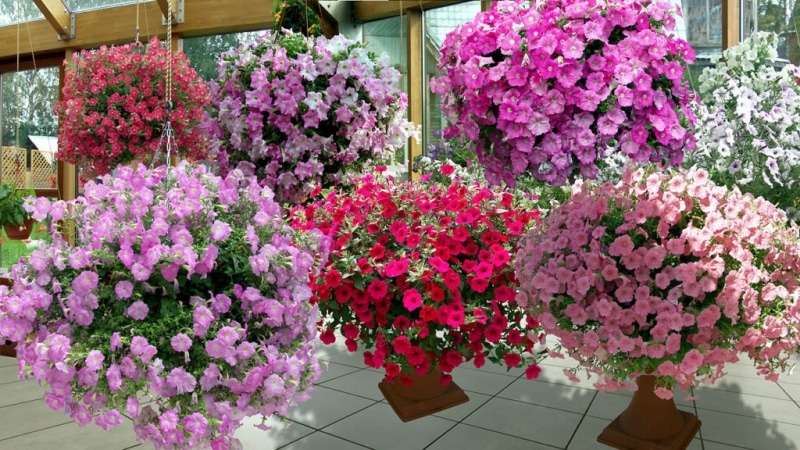
Petunia is an undemanding crop with long flowering in summer and autumn.
In warm countries petunia It is considered a perennial plant, and in Russia it is used as an annual. However, since it does not stop blooming even when transplanted, it can be dug up before frost, transplanted into a pot and then grown at home.
Petunia seeds are sold not only in gardening stores, but also in supermarkets. Depending on the variety, flowers vary significantly.
Note! Most petunias with interesting colors are hybrids. Seeds collected from such plants will not have parental characteristics.
Growing petunia for transplanting into open ground or placing on a balcony begins in the second half of February or early March. When growing a flower in an apartment as a houseplant, sowing is possible at any time.
Sowing seeds
Before growing petunia at home, prepare the seeds for planting. This does not need to be done if the planting material is pelleted.
Procedure:
- Disinfection. The seeds are soaked in a light pink solution of potassium permanganate, hydrogen peroxide, soda solution (1 teaspoon per 1 cup of water) or aloe juice diluted 1:1 with water for half an hour. Then the seeds are dried.
- Stimulation of growth. The seeds are soaked in a growth stimulator for 6-12 hours. Use “Epin”, “Kornevin”, “Rastvorin” or another drug. It is diluted with water according to the instructions.
Seeds are sown in a common container or peat tablets. The first method is more convenient, and the second allows you to do without picking - when transplanting to a permanent place, the plants do not have to be removed from the container.
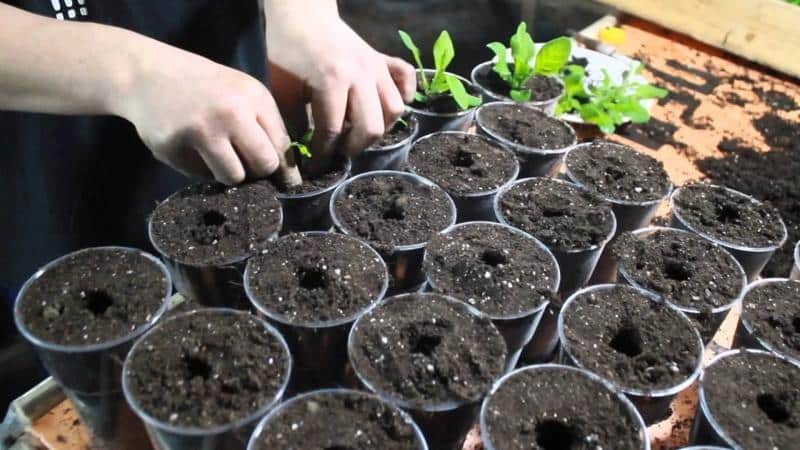
To grow seedlings, use universal soil. You can buy it in a store or prepare it yourself from 1 part earth, 1 part sand and 2 parts peat. The soil is disinfected by calcining it in the oven or pouring it with a dark pink solution of potassium permanganate.
For 5 kg of soil mixture take:
- 1 tbsp. perlite;
- 0.5 kg of ash;
- 1 tbsp. l. potassium sulfate;
- 1 tbsp. l. "Kemiry".
Disinfected drainage - ground ceramics, expanded clay, small crushed stone - is poured into the bottom of disinfected containers with drainage holes. The rest of the volume is filled with soil so that 2 cm is left free to the edge. The seeds are scattered on the ground and moistened with a spray bottle.
The container with the seeds is covered with film or transparent plastic and placed on the windowsill.Before emergence, the soil is sprayed with a spray bottle.
Important! Most hybrids with double flowers do not produce seeds, so they are grown by cuttings. The cuttings are planted in individual containers, lowered into Kornevin before planting.
Conditions for growth
When grown indoors, petunias provide optimal conditions.
Humidity
Petunia is not demanding on humidity. It is recommended to place a humidifier or containers of water next to the pot only in winter.
Temperature
Before the seeds germinate, the room temperature is maintained at +24…+25°C. After the first shoots appear, the temperature is reduced to +20-...+21°C. If you plan to grow petunia as a houseplant, after transferring it to a permanent place, room temperature will be suitable.
Lighting
Before the first shoots appear and the first few weeks after seed germination, petunia's daylight hours last for at least 16 hours. Then the plant only needs 12 hours of light. If necessary, install a fluorescent or phytolamp at a distance of 20 cm from the plants.
Caring for petunia at home
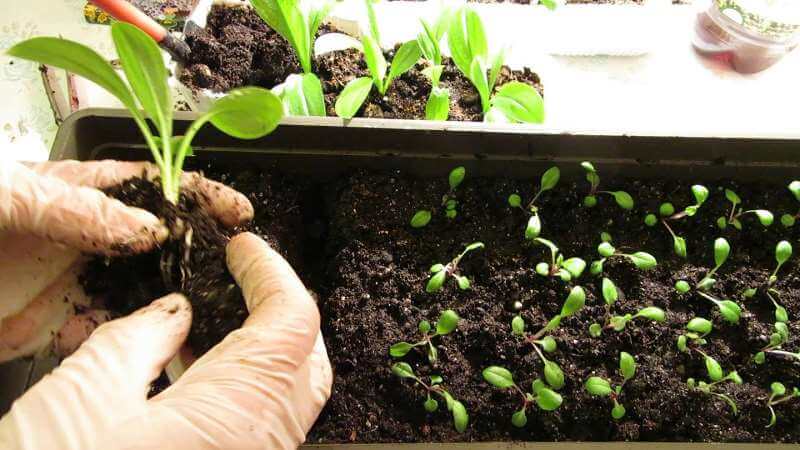
Caring for the crop includes watering, fertilizing, replanting, and pinching.
Watering
Petunia is watered as the soil dries. In this case, the water should only get to the roots and not touch the leaves. While the seedlings are in a common container, each plant is watered with a syringe.
For planted petunias, use special home watering cans. Some gardeners prefer bottom watering, which involves pouring water into a tray under the pot. To moisten the soil, use settled water at room temperature.
Feeding
Petunia is demanding on soil composition. Before the first transplant, it is fed up to 2 times a week at the root with a solution of yellow “Kristalon” and sprayed with a solution of green “Kristalon” and a light pink solution of potassium permanganate.
Two weeks after picking, foliar feeding is done with Radifarm. Next, fertilizing (Kemira, Mortar, Aquarin) is applied once every 1-2 weeks, alternating root and foliar methods.
Transfer
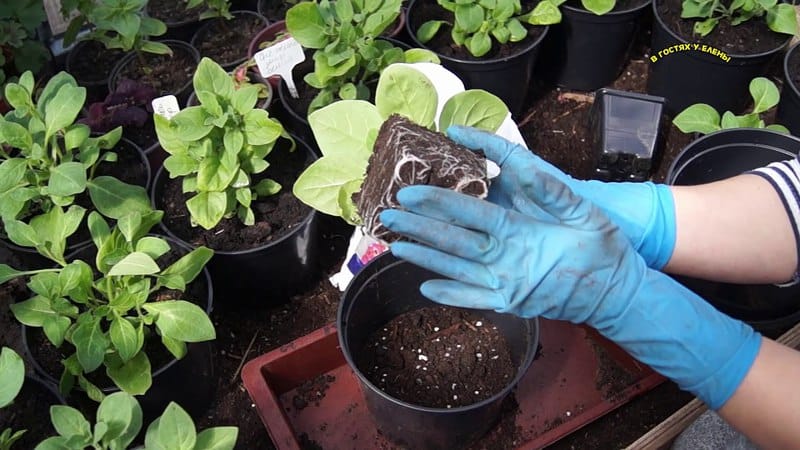
After 2-3 true leaves appear, the seedlings are transplanted into individual containers with a volume of 250-300 ml. The pots are disinfected and filled with drainage and soil. Plants are planted so that the root collar is not buried. When the petunia roots fill the entire pot, it is transferred to a 2-liter container. The petunia will remain in this container until it is planted in open ground or a permanent pot.
2 weeks before transplanting the petunia onto the street or balcony, they begin to harden it. To do this, the pot is taken out into the fresh air, gradually increasing the time spent there to a day.
If petunia is grown as a houseplant, the flower pot is periodically rotated in relation to the window.
Pinching, or why petunia stretches out
Why does petunia stretch and not bush? This happens as a result of lack of pinching. It is this procedure that allows the plant to form correctly.
Petunia is pinched when 4-5 leaves appear on the plant. The top above them is broken off. The cut area is dusted with ash. A new shoot will grow from each leaf axil - this will ensure abundant flowering and bushiness.
Sometimes petunia has to be pinched several times, as it continues to stretch despite the limited growth point. Ampelous varieties are usually not pinched.
Note! Seedlings begin to stretch out when there is a lack of sunlight.
Transplantation into open ground

Petunia is planted in open ground when its age reaches 70 days. At the same time, it is transplanted into a pot for growing on a balcony or street.
Petunia is a light-loving plant. For it to bloom, it is planted in the sunniest part of the garden.
The soil is made light and nutritious. In the fall or 3 weeks before planting flowers, it is dug up and cleared of weeds. For every 1 m² add 6-9 kg of rotted manure or humus, 20 g of potassium sulfate and 25 g of superphosphate. If the soil is heavy, sand is added, and if it is acidic, lime is added. The soil is leveled with a rake, distributing fertilizers. Then it is watered with a hot solution of copper sulfate (1 tablespoon per 10 liters of water). The application of long-acting complex fertilizers has a positive effect.
1 day before planting in open ground, seedlings are watered and fed with Kornevin. This helps it settle down faster after being transplanted to a permanent place.
The bushes are planted in open ground without deepening the root collar. Then water, spending 3-4 liters of water per 1 m². The distance between bushes should be at least 15 cm.
Advice. Petunia is a low-growing plant. It looks especially beautiful if planted along the borders, as a frame for a flower bed.
If you plan to collect seeds, different varieties are planted as far apart as possible. Otherwise, cross-pollination will occur.
Caring for petunia in the open ground
With proper nutrition, petunia blooms from late spring until the first frost. If you move it indoors before frost sets in, flowering will continue throughout the winter. Next, we will tell you how to care for petunia so that it blooms profusely.
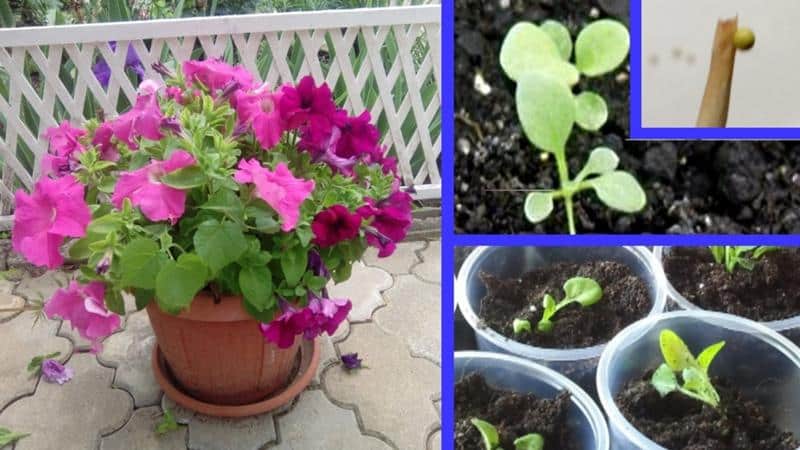
Watering
How often to water petunia in open ground? The frequency of watering depends on the outside temperature. If the weather is hot - every day. On cool days, 1 time every 2-3 days is enough. Water should only get under the root. The leaves are not sprayed. Moisten the soil early in the morning or after sunset, otherwise burns will appear on the plants. For irrigation, use settled water at room temperature.
Feeding
Fertilizer is applied to the roots at least 3 times a month. They use special fertilizers for flowers, potassium sulfate, chicken manure diluted 1:10, humus, herbal decoction, infusion of food waste, etc.
Fertilizer application at the root is alternated with foliar spraying. This will help the plant bloom faster. The day before fertilizing, water the flower garden. Fertilizers are applied when the sun is not active.
Formation
If the petunia stretches out, pinch it. Withered flowers are picked off. Old shoots are also removed - this stimulates the formation of new ones and increases the flowering period.
Loosening
After each watering, the soil is loosened. This allows you to destroy the earthen crust, which interferes with root air exchange and causes stagnation of moisture in the soil and root diseases.
Weeding
Flowerbeds are weeded while loosening the soil. Weeds not only spoil the appearance of the flower garden, but also take nutrients from the soil and also spread infections.
Mulching
The ground is covered with a layer of sawdust, straw, hay or peat. Mulch prevents the growth of weeds, reduces the frequency of loosening, and protects plants from pests, diseases and cold weather.
Disease Prevention
Chlorinated water and increased chlorine content in the soil are the causes of chlorosis, due to which flowers and leaves become less bright and take on an irregular shape. The intensity of flowering is reduced. To prevent chlorosis, iron is used in fertilizers.
note! Petunia varieties with white and light inflorescences are especially susceptible to chlorosis.
Proper wintering
When petunia blooms or before the onset of cold weather, you can dig it up. The plants are transplanted into a pot and grown on the windowsill. If you provide your petunias with regular watering, sufficient light and fertilizing, it will bloom in winter.
In spring, the plant can be used for propagation by cuttings. It is especially practical to do this with hybrid specimens.
DIY vertical flower beds for petunia

In gardening stores you can find ready-made multi-tiered structures. But vertical flower beds are easy to make with your own hands. They will decorate your garden, balcony, apartment or gazebo.
Most often they are made from scrap materials:
- Pots and containers. They are arranged into a pyramid, placed on ropes on both sides and hung.
- Plastic and metal wide pipes. Round holes are cut out on the sides of the pipe. Petunia is planted in them.
- Rabitz. It is rolled into a cylinder or cone.
- Wire. Large, voluminous geometric or fantasy figures are made from wire in which flowers are grown.
- Barrels with humus. Holes are made on the sides of the barrel into which petunia is planted. This humus cooks faster.
- Tires. They are placed on top of each other so that there is room in each tire for a flower.
Prepared vertical flower beds are filled with the same soil mixture as for seedlings.Such flower beds need more frequent watering. Gardeners recommend building devices for drip moistening of the soil.
Otherwise, caring for flower beds is no different from growing petunias in open ground. For the winter, the structures are removed indoors.
Conclusion
Growing petunia from seeds is a long process. The seedlings are kept at home for more than 2 months, providing them with optimal conditions for growth. Then they are transplanted into the garden or put the pots on the balcony.
The plant is considered unpretentious, easily tolerates transplants and blooms continuously. This delicate flower will decorate not only the garden, but also a gazebo, house or balcony.